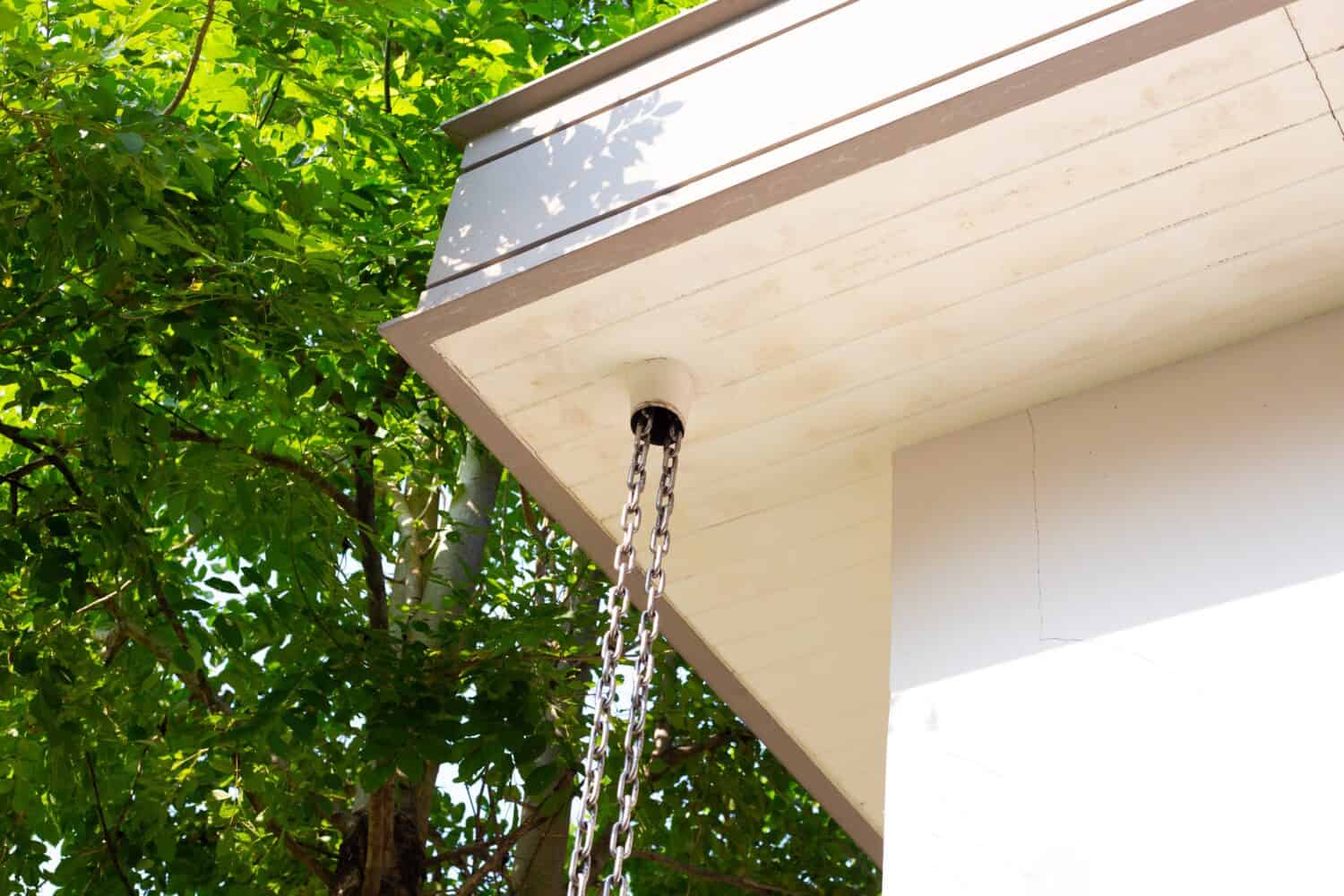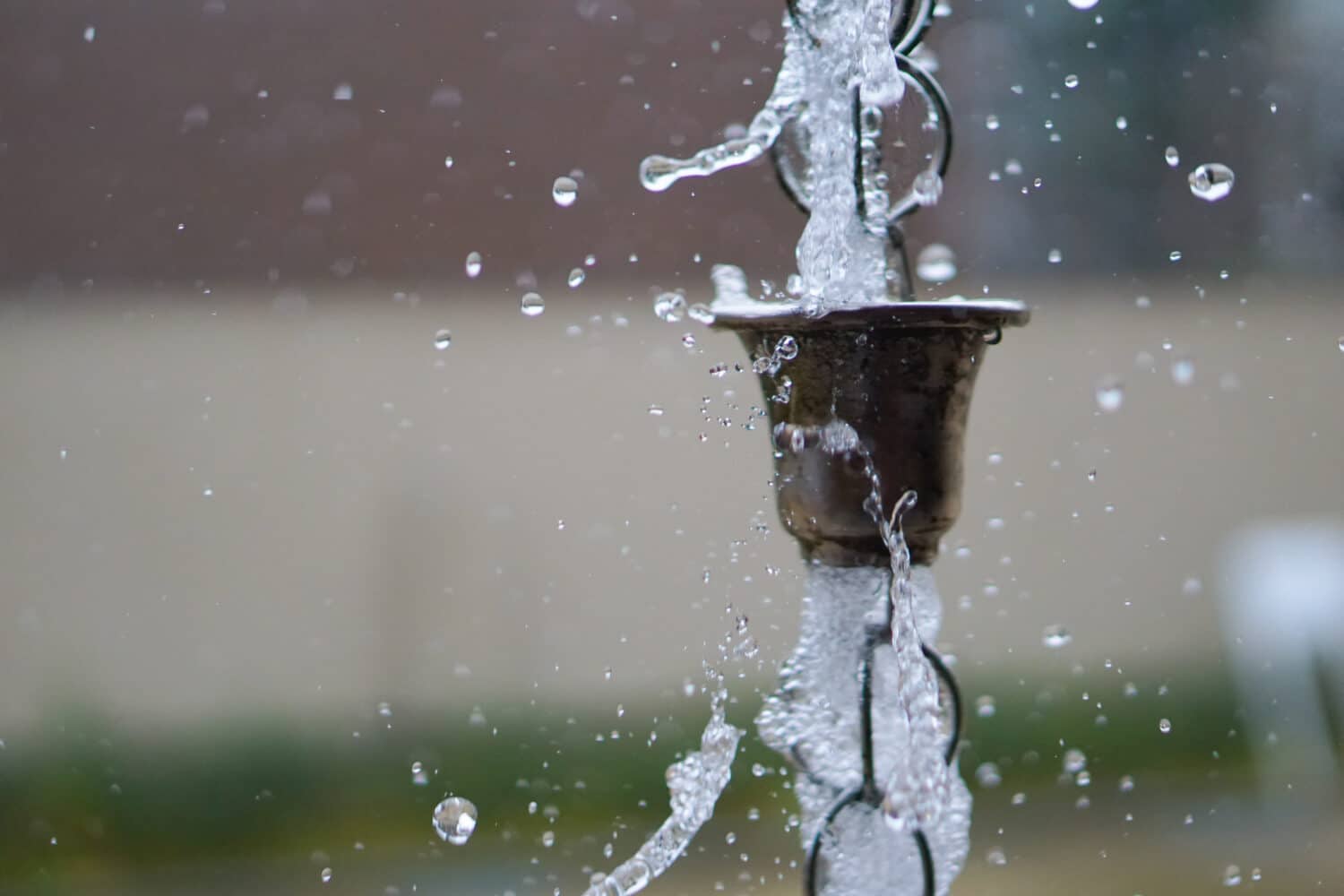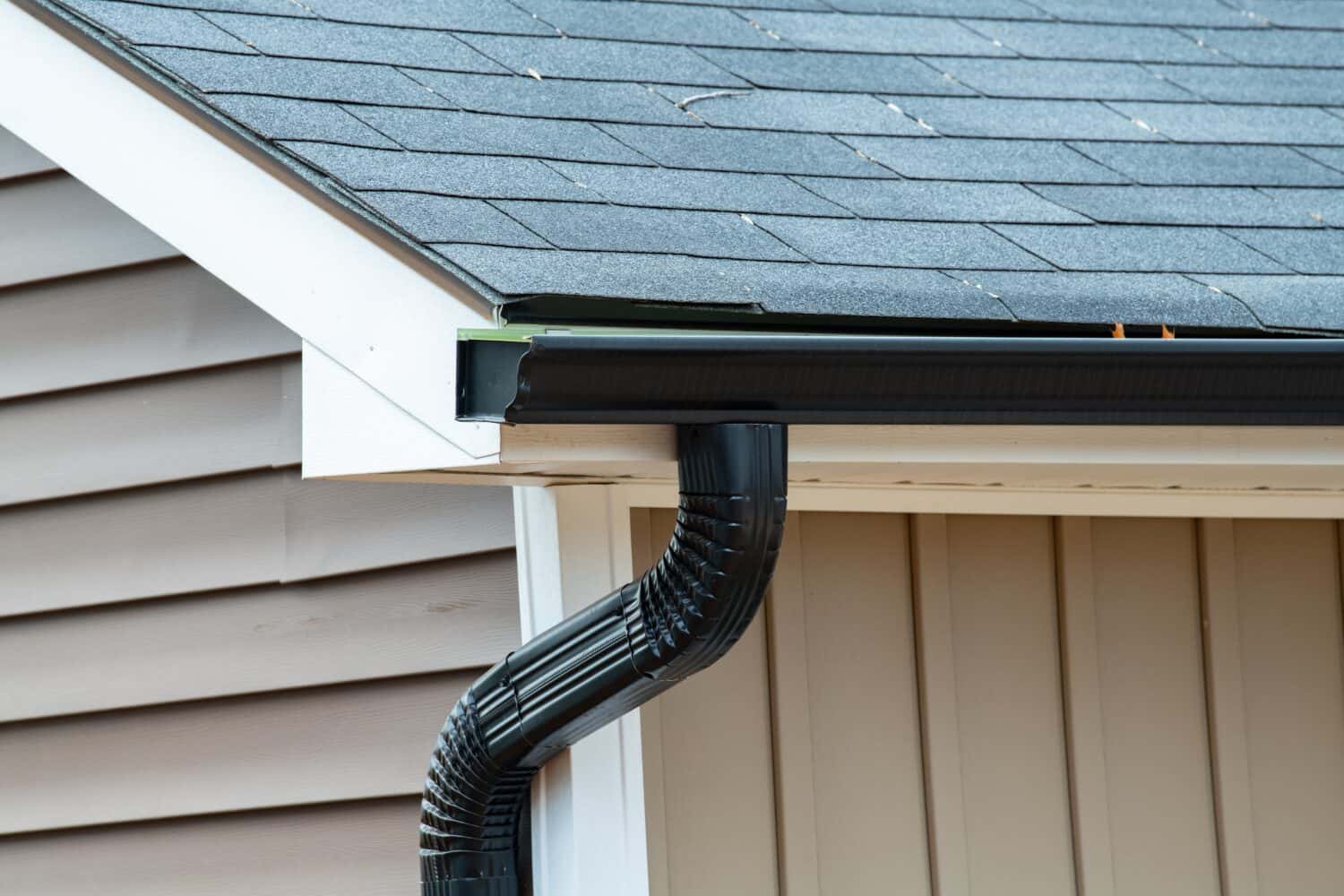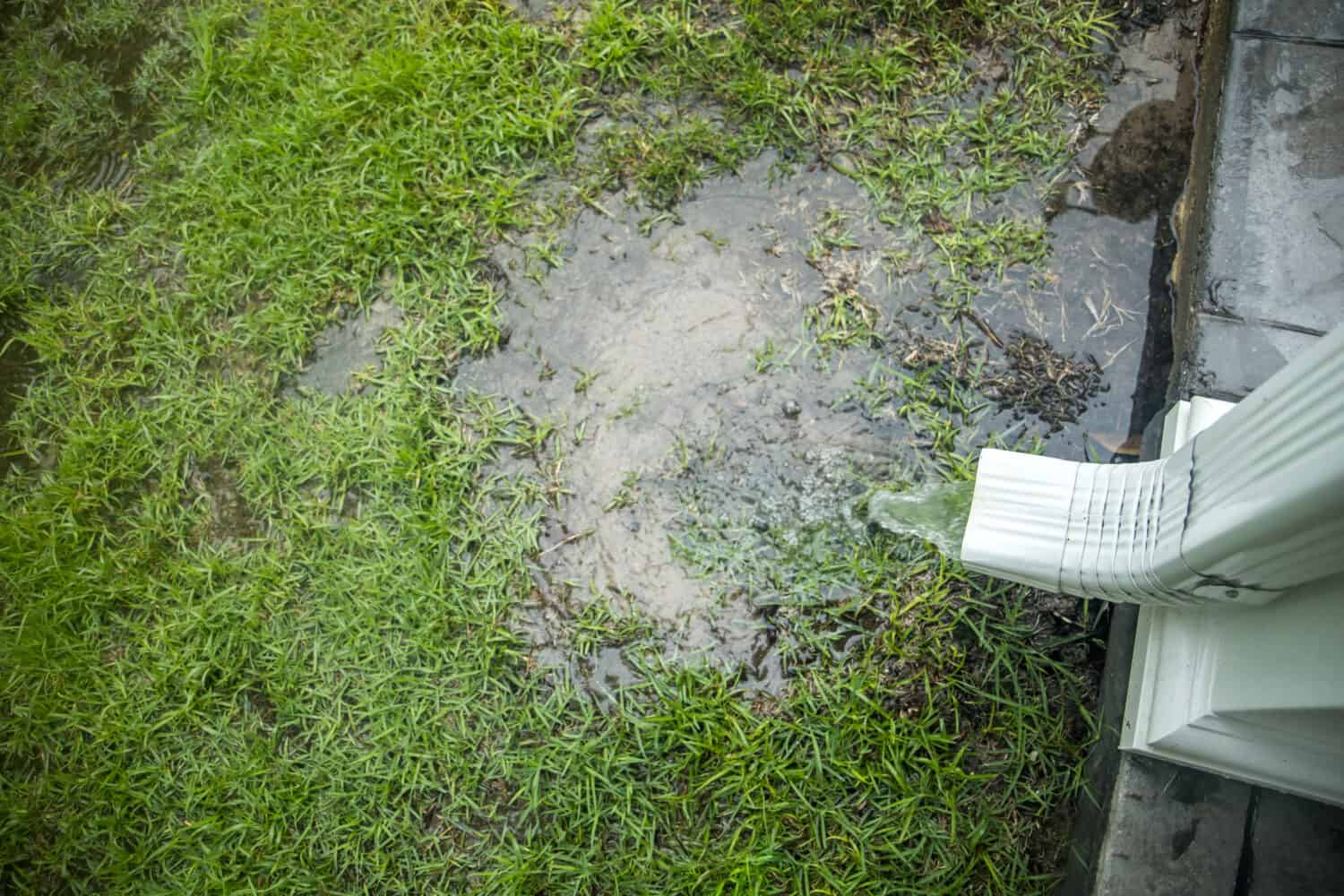Considering upgrading your home’s exterior style but don’t want to spend a ton of money? Maybe you’ve considered adding a rain chain to your gutters. These decorative chains look great but are also functional. However, are they as functional as a traditional downspout? When making the decision for your home, there are a few pros and cons to each option that you should consider.
What Is a Rain Chain?

Rain chains can be simple links or ornate decorative chains.
©Bowonpat Sakaew/Shutterstock.com
Rain chains are well-named because they are literal chains that connect to the gutters and allow the rain the slide down to the ground. But don’t think that these are any old boring chains. Rain chains come in a variety of styles and designs, most with decorative elements that make them a nice feature on the exterior of your home.
As it rains, water collects in your gutters and goes toward the rain chain. As long as there aren’t a lot of clogs from debris, leaves, or pine needles, the water should flow freely and unobstructed. When it reaches the rain chain, the surface tension causes the water to stay on the chain as gravity pulls it down the chain and to the ground.
Rain chains come in link designs or cup designs. Links can be very simple, such as basic oval or rectangular links in a variety of finishes. They can also have extra embellishments, such as decorative details made out of the same finish. As long as the rain is able to travel down the chain continuously, they work great. Cup designs include small cups that collect rainwater as it travels down. When each cup is full, the water spills out or over, moving onto the next link or cup. These can add a musical element to the rain chain. They often feature natural or garden-themed imagery, such as flowers or even watering cans. They can also be more abstract and geometrical.
Pros of Using a Rain Chain

Not only do rain chains look great, but they can also collect water and add their own musical element to the storm.
©takayan/Shutterstock.com
Rain chains add a little something special to the design of your home. Because they are thinner and less bulky than traditional downspouts, they also appear to be more delicate. They come in a variety of finishes, including black, white, silver, gold, oil-rubbed bronze, copper, and others. Most are made of durable stainless steel or aluminum, both of which do well in the elements, and powder-coated for the finish. Rain chains can help you direct the water to a particular part of your landscaping, a rain collection barrel, or another location with style.
If you like landscape and garden design, you might be more interested in rain chains. They act as an installed water feature on the exterior of your home. They are a bit more noticeable but most people opt for a rain chain because they make a visual statement. Adding a rain chain can also enhance the gentle sounds of the rain by adding its own unique melody or sound effect.
Cons of Using a Rain Chain

Rain chains have trouble keeping up with the sheer volume of water from heavy rainstorms.
©kaitong.yepoon/Shutterstock.com
Water moves a bit slower down rain chains than it does when using a traditional downspout. If you live in an area with frequent heavy rains, a rain chain might not be able to keep up with the sheer amount of water. If it can’t the water may sit in the gutter and potentially cause damage. Even if you don’t expect torrential downpours, make sure to keep a close eye on your gutters after any rain when you first install a rain chain to make sure that it can handle the amount of water that you get.
Using a cup-style rain chain can help keep the water moving a little bit faster and is a good option for those who get steady rain. You might also be able to install a single rain chain in the front of your home for the look and keep downspouts at other points to make sure the water has a place to go.
Design of a Downspout

A downspout connects to the gutter and allows the water to flow to the ground.
©Victor Yarmolyuk/Shutterstock.com
A downspout is the vertical portion of your gutter system. While many people refer to them as gutters, the correct terminology is actually downspout. These pipes connect to the gutters, which run horizontally and allow the water to flow to the ground. Like rain chains, they rely on gravity to get the water from the roofline to the ground.
Downspouts are unobstructed and water travels freely (and quickly) down the open pipe to the ground below. They do follow the profile of your home, so most have an elbow near the end. They are connected to the side of the home using brackets that match the material and finish of the downspout. While you can find them in a variety of styles and finishes, they often match either the gutters above, the siding of your home, or both.
A downspout has an elbow bend at the end to direct the water away from the base of your home. This is an important feature that keeps the water from pooling.
Pros of Using a Downspout

Downspouts can blend seamlessly into your home’s exterior.
©Victor Yarmolyuk/Shutterstock.com
A downspout can keep the water moving much faster than a rain chain. If you live in an area with frequent heavy storms and rain, it might be necessary to go with a downspout. They are also designed to be installed and work with your gutter system. If you are replacing your gutters, they might even be included in the price of the overall system.
Many downspouts come in colors that complement or blend into the siding. You might even be able to paint them to match. This makes them less noticeable and unobtrusive, even with their larger size. Of course, if you have a brick home, this isn’t an option. But there are plenty of finishes that look great next to brick.
Cons of Using a Downspout

Water exits a downspout with more force, which may cause issues with the landscaping below.
©Ursula Page/Shutterstock.com
Like gutters, downspouts can clog if there are a lot of leaves and other debris collecting in your system. Pine needles can be especially troubling because they collect in chunks as they get wet. They can manage to get into even the smallest spaces and cause problems. You may consider installing a gutter guard at the roofline to keep these pesky things out of the gutters. Of course, that adds to the overall cost of the gutter system.
Because they move water faster, it’s common to have an area directly by the end of the downspout that gets washed out. The force of the water exiting the downspout might be enough to disturb the area below, even if there isn’t all that much rain. If you add mulch or other landscaping there, heavy rain can wash it away within a few hours. Rain chains slow this down and can save your landscaping.
Is a Rain Chain Better than a Downspout?

Rain chains appeal to homeowners who want to add extra style to their home’s exterior.
©kaitong.yepoon/Shutterstock.com
Overall, the better choice between a rain chain and a downspout really depends on your climate and personal preferences. If you experience frequent heavy rains, a downspout is likely the better option to keep up with the larger amounts of water that need to be directed away from your home. For areas with less rainfall, a rain chain can be a good option that can easily keep up with the smaller or less frequent needs.
Rain chains tend to make a more impactful and noticeable style statement, which can be preferred by some homeowners. Those who like a sleeker look might go for a downspout that can easily blend into their existing exterior home design.
The photo featured at the top of this post is © Kulanun Chaiwarokul/Shutterstock.com
Thank you for reading! Have some feedback for us? Contact the AZ Animals editorial team.







